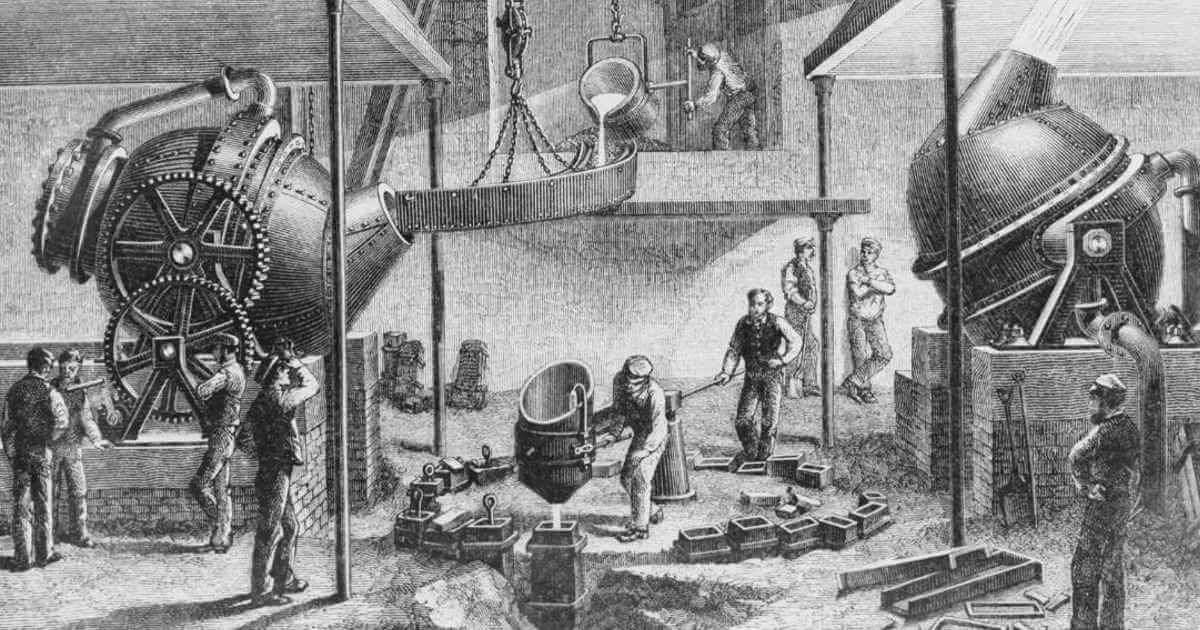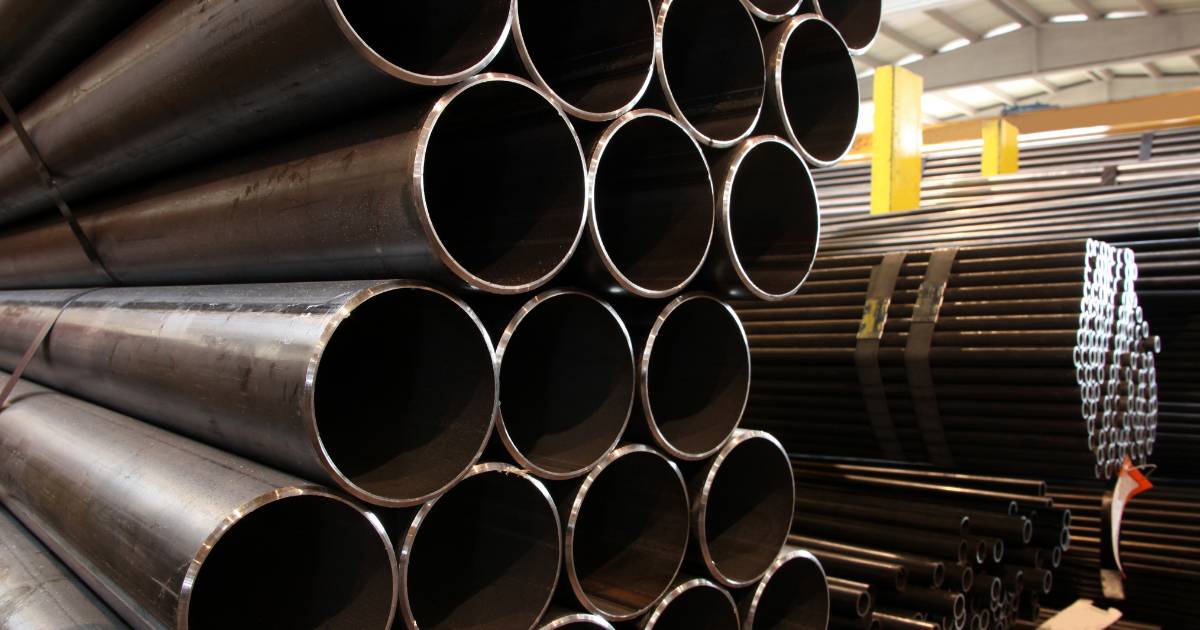The Bessemer Process stands as a groundbreaking method in the realm of steelmaking. Named after its inventor, Sir Henry Bessemer, this process revolutionized steel production during the mid-19th century.
Before its development, steelmaking was a laborious and costly process, limiting its widespread usage. The Bessemer Process introduced an efficient and economical approach to producing high-quality steel, paving the way for significant advancements in industrialization and infrastructure.
Bessemer Process enables the mass production of steel. It fueled the rapid growth of construction, transportation, and manufacturing industries. The availability of affordable steel played a pivotal role in the construction of bridges, railways, skyscrapers, and machinery, transforming the face of modern civilization.
Development of the Bessemer Process
Before the advent of the Bessemer Process, steelmaking was a labor-intensive and time-consuming process that relied on converting iron into steel through intricate and costly procedures.
In 1855, Bessemer developed a revolutionary concept that involved blowing air through molten iron to remove impurities and convert it into steel. This process, known as the Bessemer Process, was a remarkable breakthrough in steel production.
Bessemer’s key innovation was using a sizeable pear-shaped vessel called a converter, which could hold several tons of molten iron. By blowing air through the molten metal, Bessemer could oxidize impurities such as carbon, silicon, and manganese, removing these unwanted elements and producing high-quality steel.
The Timeline of the Bessemer Process
1856: Henry Bessemer filed a patent for his steelmaking process.
1856-1860: Bessemer faced initial challenges and technical difficulties in scaling up the process for commercial production.
1860: Bessemer successfully demonstrated the viability of the process by producing large quantities of high-quality steel.
1865: The first Bessemer steel plant was established in Sheffield, England, marking the beginning of widespread adoption of the process.
Late 19th century: The Bessemer Process gained momentum globally, with steel mills established in various countries, including the United States, Germany, and France.
Explaining the Bessemer Process
 Image: Universal History Archive/Getty Images
Image: Universal History Archive/Getty Images
The Bessemer Process is a batch steelmaking process that involves the conversion of molten iron into steel by blowing air through it. The basic principle behind the process is the removal of impurities and the controlled oxidation of elements present in the molten iron to achieve the desired composition and properties of steel.
Charging the converter: A pear-shaped vessel made of iron or steel is preheated and then charged with molten iron. The converter is mounted on trunnions, allowing it to tilt for pouring.
Blowing air: Compressed air is blown into the molten iron through nozzles or tuyeres at the converter’s bottom. The air oxidizes the impurities in the iron, primarily carbon, silicon, and manganese, forming oxides that are either gaseous or semi-solid.
Decarburization and removal of impurities: As the air passes through the molten iron, it reacts with the impurities, primarily carbon, converting it into carbon monoxide gas. This process, known as decarburization, leads to a reduction in the carbon content of the iron, resulting in the production of steel.
Monitoring and adjustment: Throughout the blowing process, the operator monitors various parameters such as temperature, carbon content, and appearance of the slag. These observations guide the adjustment of the blowing process to achieve the desired steel composition.
Pouring the steel: Once the desired steel composition is achieved, the converter is tilted, and the liquid steel is poured into ladles for further processing or casting.
Advantages and Significance of the Bessemer Process
- Increased Efficiency and Productivity – Bessemer Process allowed for much faster production times, as blowing air through the molten iron facilitated rapid oxidation and removal of impurities. This efficiency improvement resulted in a substantial increase in the volume of steel that could be produced within a given timeframe, revolutionizing the industry.
- Lower Production Costs – By enabling cheaper raw materials, particularly pig iron, instead of costly wrought iron, the process significantly reduced the overall cost of steel production. The efficiency and speed of the process meant reduced labor requirements and energy consumption, further contributing to cost savings.
- Expansion of the Steel Industry and Applications – The newfound ability to produce large quantities of steel quickly and economically spurred the establishment of numerous steel mills and facilitated the growth of steel-producing regions. Steel became the material of choice for various applications, including the construction of buildings, bridges, railways, ships, and machinery.
- Historical and Industrial Impact – The mass production of steel enabled by the process laid the foundation for modern industrial economies. The Bessemer Process was vital in shaping the infrastructure, transportation systems, and manufacturing capabilities.
Limitations and Improvements

Variability in raw materials: Look into the quality and composition of the raw materials used. This variability often posed difficulties in achieving consistent and desired steel quality.
Phosphorus contamination: The Bessemer Process did not remove phosphorus from the molten iron. High phosphorus content in the steel resulted in brittleness, making it unsuitable for specific applications.
Over-oxidation: Excessive air blowing could lead to over-oxidation of the molten metal. This results in excessive loss of valuable alloying elements such as manganese and chromium.
Lack of control over carbon content: The process initially had limited control over the carbon content in the resulting steel. This made producing steels with specific carbon concentrations challenging, determining their suitability for certain applications.
Legacy and Influence
The Bessemer Process rapidly spread across the globe following its successful implementation. Steel mills were established in major industrial regions. It includes Sheffield in England, Pittsburgh in the United States, and the Ruhr Valley in Germany.
The availability of affordable steel revolutionized infrastructure construction and contributed to modern cities and urban landscapes. The process also created employment opportunities and spurred population migration to industrial regions, leading to the growth of urban centers.
Impact of the Bessemer Process
The Bessemer Process enabled mass steel production. It offers increased efficiency, lower production costs, and the ability to meet the growing demand.
The process transformed the steel industry, facilitating the construction of iconic structures, driving economic growth, and creating employment opportunities. Its development marked a turning point in steel production. It shifts from laborious and expensive methods to a fast and cost-effective approach.
The steel industry still feels the lasting impact of the Bessemer Process today. It expanded the availability and affordability of steel, driving its widespread adoption in various applications. The process led to the establishment of steel mills globally, fueling industrial development and urbanization.
Our Locations
Get a Quote Now

